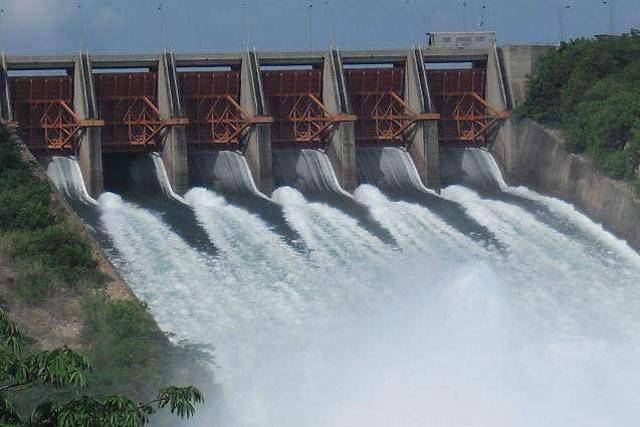Islamabad - The mystery of losing 100,000 cusecs of water from Besham to Tarbella in the River Indus has not been resolved and the Indus River System Authority (Irsa) has asked Wapda to investigate the matter.
After the water flows in River Indus increased in the wake of enhanced temperature in the catchment areas, daily 80,000 to 100,000 cusecs water is disappearing from Besham to Tarbella, official source told The Nation here Sunday.
It takes 24 to 48 hours for water to reach from Besham to Tarbela but the missing of such huge quantity is a big mystery, source said. For example, at Partab, a location on River Indus, the water flows are 275,000 cusecs, which reach to 300,000 at Besham but only 210,000 cusecs reach to Tarbela, the source said.
Last Friday, the water flow at Besham was 307,000 cusecs but the water reaching Tarbela was 207,000 causes.
There is no outlet from Besham to Tarbela and the loss of such a big quantity is a mystery which needs to be probed, the source said.
"Now we have written a letter to Wapda to investigate the matter as it is a serious matter which is affecting the water storage," the official source said.
They added that one possibility is that Wapda is not providing exact data to IRSA and hiding the extra water. Wapda may be releasing more water than the provinces and using extra water for the hydropower generation, the source said.
Wapda is not allowed to release extra water for hydropower generation because the prime purpose of Tarbela is meeting irrigation requirements and not hydro demand, they said. They added, “We want to store water for Rabi season but daily losing such a big quantity is negatively impacting the move.”
The water storage on Sunday reached 3.1 MAF. The position of the river inflows and outflows at Tarbela, Mangla and Chashma along with the reservoirs levels and the barrages was as follows: inflows in Indus at Tarbela were 249600 cusecs and outflows 110200 cusecs; inflows in Kabul at Nowshera 63000 cusecs and outflows 63000 cusecs; inflows in Jhelum at Mangla 33400 cusecs and outflows 10000 cusecs, inflows in Chenab at Marala 81400 cusecs and outflows 48500 cusecs.
Inflows in Jinnah Barrage were 185000 cusecs and outflows 177000 cusecs, Chashma inflows 203200 cusecs and outflows 190000 cusecs, Taunsa inflows 200500 cusecs and outflows 181400 cusecs, Panjnad inflows 15400 cusecs and outflows 1200 cusecs Guddu inflows 147700 cusecs and outflows 107400 cusecs, Sukkur inflows 95100 cusecs and outflows 44300, Kotri inflows 35100 Cusecs.
Tarbela against the minimum operating level of 1386 feet is presently at 1461.88 feet. The maximum conservation level of Tarbela is 1550 feet. Mangla against minimum operating level of 1050 feet is presently 1132.50 feet. Maximum conservation level of Tarbela is 1242 feet.
Chashma against the minimum operating level of 638.15 feet is presently 648.20 feet. The maximum conservation level of Chashma is 649 feet.
APP adds: Senator Dr Musadik Malik has claimed that last Pakistan Muslim League Nawaz (PML-N) government had produced over 10,000 mega watt energy from hydel, wind, solar and coal resources.
About 10,000MW electricity had been added to national grid during five year period of last government, he said while talking to a private news channel. The PML-N government had acquired the land for construction of Bhasha dam so that the water reservoir could be utilized for generating electricity besides meeting demand of agriculture sector, he said.
We had transmitted 21,000MW electricity during a short period of time but there was a problem in transmission lines, which he said needed to improve for avoid tripping in the system.
The country had to face 18-hours loadshedding in 2013 but it was the PML-N government's efforts of the leaders, who took initiatives and remove the power loadshedding from the country, he added. To a question about construction of dams, he said potential was available in the Indus water to achieve the objectives.
Dr Musadik Malik said that construction of water reservoirs would be given top priority if the PML-N comes into power after this election.
He said that the PML-N last government had made progress in Neelum-Jhelum, Nandipur, Tarbella IV, Port Qasim coal project, Quaid-e-Azam solar and other projects besides adding 10,000 MW electricity to national grid. He said China Pakistan Economic Corridor would be the game changer for the people of this country.
To another question he said there was need to bridge the gap between demand and supply besides improving the transmission lines for providing uninterrupted power to the country.
Earlier, the Executive Committee of the National Economic Council (Ecnec) approved Rs474 billion for the construction of Diamer-Bhasha Dam to help the country tackle two major issues—water shortage and power generation. The Ecnec meeting had approved the much-awaited funding for the project. The delay was due to reluctance from international financial institutions and China. The project is expected to complete in five years.
As per proposed plan, the dam will have a 6.4 million acre foot (MAF) live storage capacity and installed power capacity of 4,500 MW. After completion, the project will increase national water storage capacity of Pakistan from 38 days to 45 days and will enhance life span on downstream reservoirs including Tarbela Dam.






